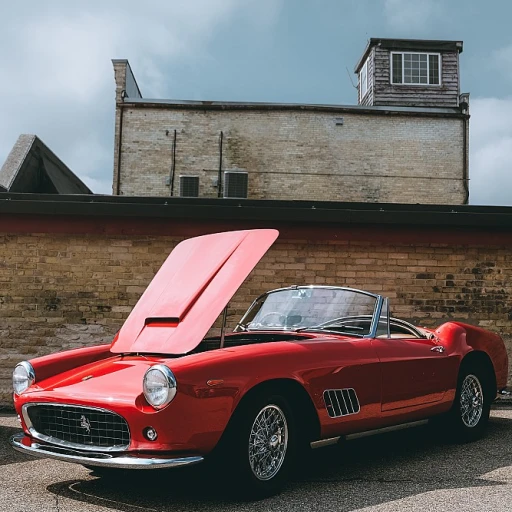
The Evolution of Safety in Luxury Cars
The Journey from Mechanical to Digital
Luxury cars have long been synonymous with cutting-edge advancements, especially in the realm of safety. Over the decades, the evolution from basic mechanical systems to sophisticated digital networks has charted a transformative path in vehicle safety. In the early days, luxury vehicles featured enhanced build quality and pioneering elements like seat belts and hydraulic brakes. Over time, substantial leaps were made, leading to the integration of anti-lock braking systems (ABS) and reinforced structural designs. This evolution laid a foundation for contemporary innovations in driver safety and experience.Transition to Driver Assistance and Smart Technologies
As we transitioned from mechanical systems, the advent of computerized systems marked a decisive shift. Today, contemporary luxury vehicles are equipped with state-of-the-art driver assistance systems that blend the line between manual and automated control seamlessly. These advancements include adaptive cruise control, lane-keeping assist, and automated emergency braking. The integration of advanced sensor and camera systems has further enhanced the reliability and precision of these features, ensuring a safer driving experience. Combining these elements not only enhances safety but also positions luxury vehicles as pioneers of automotive excellence. For a deeper understanding of the comprehensive journey luxury cars have taken towards safety, consider exploring how advanced lighting systems in luxury cars justify their exclusive status which offers additional insights into this captivating evolution.State-of-the-Art Driver Assistance Systems
Modern Driver Assistance: Enhancing Safety
In today's fast-paced world, luxury vehicles are setting a new standard with state-of-the-art driver assistance systems. These advanced technologies are not only about convenience but focus heavily on enhancing safety. They incorporate a range of features aimed at minimizing the likelihood of collisions and improving the overall driving experience. Modern luxury cars often include:- Adaptive Cruise Control: This system maintains a safe distance from the vehicle ahead, adjusting speed as necessary. It's a crucial feature for highway driving, ensuring comfort even during long commutes.
- Lane Keeping Assist: By sensing lane markings on the road, this feature gently steers the vehicle back into place if it begins to drift. This helps prevent potential accidents due to driver distraction or drowsiness.
- Blind Spot Monitoring: This assists in safely changing lanes by illuminating a warning light when another vehicle is in the blind spot, thus allowing the driver to make informed decisions.
- Traffic Sign Recognition: The system spotlights when a new speed limit is detected or warns of upcoming traffic lights, aiding in adherence to road rules.
Innovative Airbag Technologies
Revolutionizing Airbag Systems in Luxury Cars
In the realm of luxury cars, safety features have evolved significantly, with airbag technology at the forefront of this transformation. Modern luxury vehicles, such as those from Mercedes-Benz and Volvo, are equipped with innovative airbag systems that go beyond the standard front and side airbags. These systems are designed to provide comprehensive protection, ensuring that both drivers and passengers are safeguarded in various collision scenarios.
One of the standout features in today's luxury cars is the inclusion of adaptive airbag systems. These systems adjust the deployment force based on the severity of the impact and the position of the occupants, offering a tailored response that enhances safety. For instance, the latest models from Bentley and other top-tier brands incorporate sensors that detect the size and weight of passengers, allowing airbags to deploy with optimal force.
Moreover, luxury SUVs and sedans are now integrating rear-seat airbags, a feature that was once a rarity. This addition is particularly beneficial in rear-end collisions, providing an extra layer of protection for backseat passengers. The implementation of these airbags is a testament to the commitment of luxury car manufacturers to prioritize passenger safety across all seating positions.
Another noteworthy advancement is the development of pedestrian airbags, which deploy from the hood of the car in the event of a collision with a pedestrian. This feature is becoming a standard in many high-end vehicles, reflecting the industry's dedication to enhancing safety not just for occupants but for all road users.
As we look to the future, the integration of hybrid innovations and artificial intelligence in vehicle safety systems will likely lead to even more sophisticated airbag technologies. These advancements will continue to set the benchmark for what defines the safest luxury cars on the market.
Advanced Sensor and Camera Systems
Enhancing Awareness with Precision Technologies
Modern luxury cars are synonymous with advanced sensor and camera systems, which play a pivotal role in enhancing driver awareness and vehicle safety. These technologies have evolved considerably over the years, becoming indispensable in the development of intelligent driver safety features. Luxury cars incorporate a sophisticated network of sensors and cameras designed to monitor the vehicle's surroundings comprehensively. These systems work in tandem, ensuring that even the most subtle changes in the environment are detected. This intricate setup allows for meticulous monitoring of blind spots, pedestrian movements, and lane positions.- Surround View Camera Systems: By providing a 360-degree view around the vehicle, surround view cameras prevent accidents by enabling drivers to see all angles, minimizing the risk of collision when navigating tight spaces.
- Blind Spot Detection: Through the use of advanced radar and camera modules, these systems alert drivers to the presence of objects in their blind spots. The alert can manifest in different forms, such as visual indicators on the side mirrors or audible warnings.
- Rear View Cameras and Sensors: These have become a standard feature in luxury vehicles, assisting with parking and reducing the risk of reversing accidents.
The Role of Artificial Intelligence in Vehicle Safety
Harnessing the Power of Artificial Intelligence for Enhanced Safety
The integration of artificial intelligence (AI) within the luxury car sector marks a remarkable transformation in the way safety is addressed. Today's luxury vehicles leverage AI to provide an unparalleled level of protection and convenience, harmonizing with other state-of-the-art systems like advanced sensors and cameras, as well as innovative airbag technologies. AI systems in luxury cars are designed to assist drivers by interpreting data from a vast array of sensors, enabling real-time decision-making. This technology allows vehicles to predict potential hazards and avert collisions. The use of machine learning algorithms further refines the system's ability to continuously adapt, offering a tailored driving experience that enhances both safety and performance. Moreover, AI contributes to the development of autonomous driving features. These features include lane-keeping assist, adaptive cruise control, and automatic emergency braking. Each element of this advanced technology architecture comes together to create a robust safety net for drivers and passengers alike. AI’s real capability shines through in its ability to analyze vast quantities of data and respond with precision. This capability ensures that luxury cars not only react to changes in the environment faster than a human could but can also provide insights into the driver’s habits, fostering an environment of proactive safety. As luxury car manufacturers continue to prioritize safety, the role of AI only becomes more central. The partnership between AI and other modern safety features illustrates a future where risk on the road is significantly minimized, making luxury cars leaders in pioneering safety advancements.Future Trends in Luxury Car Safety
Embracing the Horizon of Safety Innovation
In the arena of luxury car manufacturing, safety advancements are not just iterative; they are transformative. While state-of-the-art driver assistance systems have already set a high benchmark, the future envisages even more integrated, intelligent, and intuitive safety solutions. Here are some trends that could redefine the safety landscape in luxury vehicles:- Integrative Connectivity: Cars are set to become more connected, enabling vehicles to communicate with each other and infrastructure. This vehicle-to-everything (V2X) communication promises to offer real-time updates on road conditions, potential hazards, and even traffic management, thus significantly reducing accidents and enhancing safety.
- AI and Predictive Analytics: Building on the role of artificial intelligence, we foresee systems capable of predictive analytics not just reacting to immediate dangers but forecasting them based on a combination of driver behavior, environmental conditions, and historical data.
- Revolutionary Sensor Technology: Existing sensor and camera systems are evolving rapidly. Future iterations may combine data from a multitude of sources - radar, lidar, ultrasonic, and thermal imaging - to create a comprehensive picture of surroundings, functioning flawlessly in diverse environments.
- Augmented Reality (AR) Interfaces: While initially explored under innovative airbag technologies, augmented reality dashboards can indeed elevate driver awareness and decision-making by overlaying critical information about the vehicle and road conditions onto the driver's field of vision without causing distractions.
- Eco-conscious Innovations: As sustainability gains precedence, eco-friendly materials and energy-efficient manufacturing processes for safety features will become more integrated, emphasizing the shift towards greener luxury.













